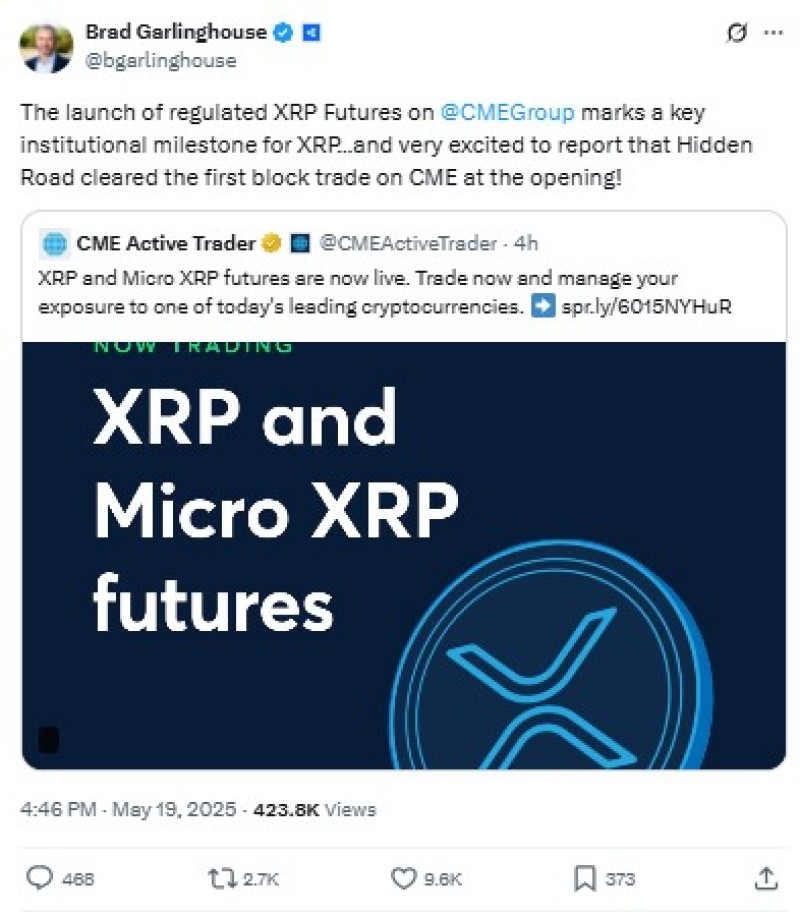- CME Group Makes XRP Futures Official
- What These XRP Futures Actually Do
- Market Says "Meh" to XRP Futures Launch
- Ripple CEO Brad Garlinghouse is Pumped
- Will Anyone Actually Trade These Things?
- Hidden Road Playing a Key Role in XRP Trading
- What This Means for XRP's Future
- The Bottom Line on XRP Futures
CME Group just dropped XRP futures trading, and Ripple's CEO is calling it a huge win for institutional adoption—even though XRP itself is down 4% today.
CME Group Makes XRP Futures Official
Well, it finally happened. The Chicago Mercantile Exchange—you know, one of the biggest and most respected trading floors in the world—officially launched XRP futures trading. This has been in the works for months, and crypto folks have been waiting for this moment like kids on Christmas morning.
The launch includes both regular and micro futures contracts, giving traders different ways to get exposure to XRP without actually having to buy and hold the token itself. For big institutions that want to dabble in crypto but don't want the headache of storing digital assets, this is exactly what they've been asking for.
What These XRP Futures Actually Do
So what can you do with these new futures contracts? Quite a bit, actually. Traders can do simple buy-and-sell trades at current market prices, or they can set up deals to buy or sell XRP futures at a fixed price based on where the market closes that day. Pretty standard stuff for futures trading.
The real exciting part is the block trades feature. This lets big institutional players—think hedge funds and investment banks—move massive amounts of contracts without turning the market upside down. It's like being able to buy a huge chunk of something without everyone else noticing and driving the price through the roof.
And here's a fun fact: Hidden Road, the company Ripple bought for $1.25 billion earlier this year, executed the very first block trade when the market opened. Talk about putting your money where your mouth is.
Market Says "Meh" to XRP Futures Launch
Here's the weird part: despite all the fanfare, XRP's price actually went down nearly 4% in the past 24 hours. You'd think launching on CME would send the token to the moon, right? Not so much.
But honestly, this isn't that surprising. CME first announced they were planning XRP futures back in April, so traders have had months to position themselves. By the time something actually launches, a lot of the excitement—and price movement—has already happened. It's like when a movie gets hyped for months before release, and then everyone's already seen the trailers a million times.
Ripple CEO Brad Garlinghouse is Pumped
Ripple's CEO Brad Garlinghouse is treating this like the biggest thing since sliced bread, and you can't really blame him. Having CME—one of the most legit exchanges in traditional finance—offer XRP futures is like getting a stamp of approval from the old-school financial world.

This fits perfectly with Ripple's game plan of positioning XRP as the go-to token for banks and financial institutions doing cross-border payments. Now these institutions have a way to manage their XRP risk through regulated futures, which should make them way more comfortable exploring XRP-based solutions.
Will Anyone Actually Trade These Things?
The million-dollar question is whether people will actually trade these futures in meaningful volumes. Industry watchers are glued to their screens, tracking every trade to see if there's real institutional demand or if this will be another "build it and they won't come" situation.
History isn't super encouraging here. When CME launched Solana futures back in March, the volume was pretty underwhelming, and it barely moved SOL's price. Sometimes these big institutional launches are more about symbolism than actual market impact—at least in the short term.
Hidden Road Playing a Key Role in XRP Trading
Remember that $1.25 billion Ripple spent on Hidden Road? Well, it's already paying off. The prime brokerage firm jumped right in and executed the first block trade on the new platform. This shows Ripple isn't just sitting on the sidelines—they're actively participating in building the trading infrastructure around their own token.
This acquisition was clearly part of a bigger strategy. Ripple isn't just focused on getting banks to use XRP for payments; they're also building the pipes and plumbing that institutional traders need to feel comfortable trading the token.
What This Means for XRP's Future
The CME futures launch is way bigger than just another trading product. It's another brick in the wall of crypto going mainstream. For XRP specifically, this could be the nudge that conservative financial institutions needed to start taking the token seriously.
If these futures take off, don't be surprised if other big exchanges follow suit with their own XRP products. And if they flop? Well, that might tell us something about how ready institutions really are to embrace crypto in a big way.
The Bottom Line on XRP Futures
At the end of the day, CME launching XRP futures is a big deal for legitimizing crypto in traditional finance circles. Sure, the immediate price reaction was a bit of a buzzkill, but these things often take time to show their real impact.
The real test will be whether institutional traders actually use these futures in meaningful volumes over the coming weeks and months. If they do, this could be the beginning of a new chapter for XRP's institutional adoption story. If not, well, at least Ripple can say they made it to the big leagues—even if the market isn't throwing a parade just yet.
 Saad Ullah
Saad Ullah

 Saad Ullah
Saad Ullah

